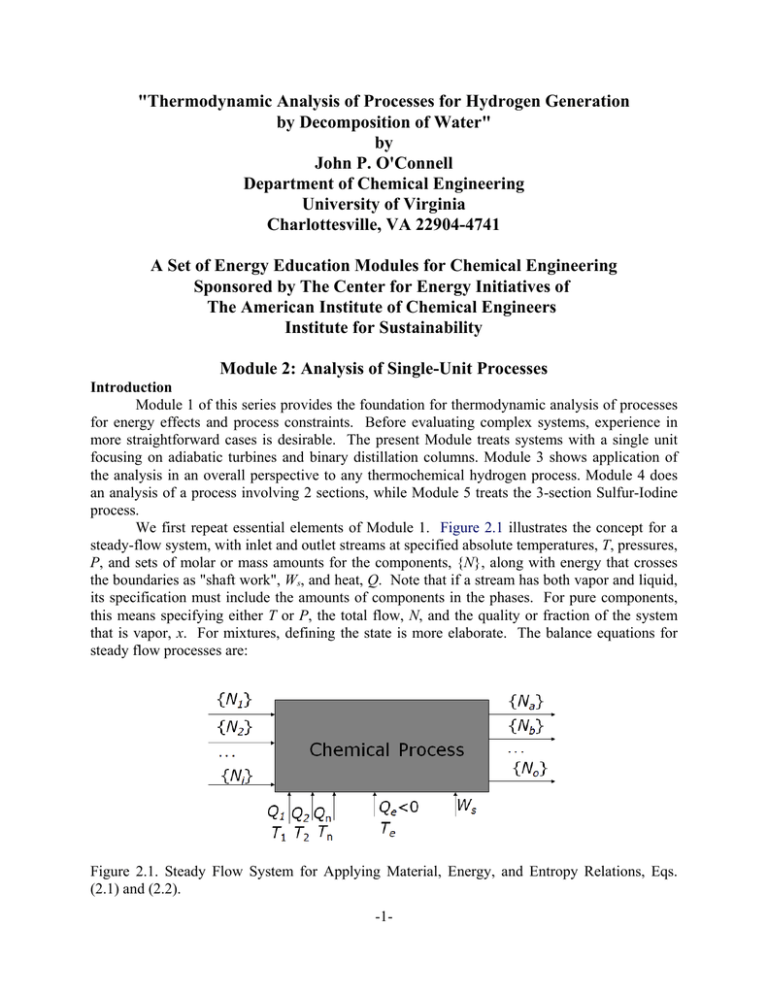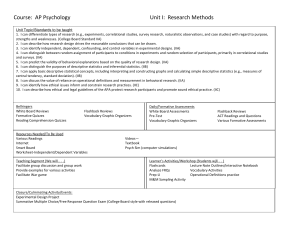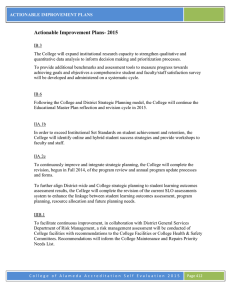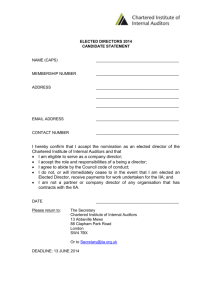Module 2
advertisement

"Thermodynamic Analysis of Processes for Hydrogen Generation
by Decomposition of Water"
by
John P. O'Connell
Department of Chemical Engineering
University of Virginia
Charlottesville, VA 22904-4741
A Set of Energy Education Modules for Chemical Engineering
Sponsored by The Center for Energy Initiatives of
The American Institute of Chemical Engineers
Institute for Sustainability
Module 2: Analysis of Single-Unit Processes
Introduction
Module 1 of this series provides the foundation for thermodynamic analysis of processes
for energy effects and process constraints. Before evaluating complex systems, experience in
more straightforward cases is desirable. The present Module treats systems with a single unit
focusing on adiabatic turbines and binary distillation columns. Module 3 shows application of
the analysis in an overall perspective to any thermochemical hydrogen process. Module 4 does
an analysis of a process involving 2 sections, while Module 5 treats the 3-section Sulfur-Iodine
process.
We first repeat essential elements of Module 1. Figure 2.1 illustrates the concept for a
steady-flow system, with inlet and outlet streams at specified absolute temperatures, T, pressures,
P, and sets of molar or mass amounts for the components, {N}, along with energy that crosses
the boundaries as "shaft work", Ws, and heat, Q. Note that if a stream has both vapor and liquid,
its specification must include the amounts of components in the phases. For pure components,
this means specifying either T or P, the total flow, N, and the quality or fraction of the system
that is vapor, x. For mixtures, defining the state is more elaborate. The balance equations for
steady flow processes are:
Figure 2.1. Steady Flow System for Applying Material, Energy, and Entropy Relations, Eqs.
(2.1) and (2.2).
-1-
i N i h i (T i , P i , x i ) i N o h o (T o , P o , x o ) s W s b Q b Q e 0
Q
Q
i N i s i (T i , P i , x i ) i N o s o (T o , P o , x o ) b Tbb Tee S gen 0
(2.1)
(2.2)
Here h is the molar enthalpy, s is the molar entropy, and {x} is the set of component mole
fractions found from the set of numbers of moles of components, {N}, in a stream. Kinetic and
potential energy differences in the flowing streams have been ignored in Eq. (2.1). The
summation is over all input streams, i, and the summation
is over all output streams, o.
o
i
Consequently, all molar flow numbers, {N}i and {N}o, are positive. The summations s and are
b
for the work and heat effects, respectively, associated with external utilities. The species
amounts, {N}i and {N}o are related by mass conservation; moles are conserved only in
nonreacting systems.
These two relations express the conservation of energy among the forms generally treated
in chemical processes, Eq. (2.1), and the balance of entropy, Eq. (2.2), which has entropy
conservation for reversible cases (sgen rev = 0) and positive entropy generation (sgen > 0) in real
systems. The heat effects, {Qb} and Qe, are defined to be positive when heat is put in; they cross
the outside of the system boundary (surroundings) at temperatures Tb and Te. A reversible
process gives the absolute upper limit, the best case, of the efficiency of energy usage. That is,
when sgen = 0, the solution to Eqs. (2.1) and (2.2) will give the minimum input shaft work,
high-temperature heat, or energy-carrying material, to accomplish a process that does not occur
spontaneously.
The two energy/entropy relations force two unknown quantities to be found from the
known variable values, while giving consistency among molar flows for all chemical reactions
occurring. Thus, many different cases can be set up; Table 2.1 illustrates a few of these relevant
to this Module. Others are given in Table 1.1 of Module 1.
Table 2.1 Options for Specifications and Solution Variables for Eqs. (2.1) and (2.2).
Case
Specifications
C
T i , Pi , N i, , T o , Po , N o , Ws , Qb , T b , T e , Qe
D
T i , Pi , N i, T o , P o , N o , Ws , Qb , T b , T e
E
T i , Pi , N i, , Po , N o , Ws , Qb , T b , T e , Qe
F
T i , P i , N i, , P o , N o , W s , Q b , T b , T e , Q e , s gen
H
Ti , Pi , N i, , To , Po , N o , Ws , Qb , T b , Te , Qe , s gen
* Includes all elements of set except n which is solved for
Solution Variables
Wsn , s gen
Qe , s gen
To , s gen
T o , N in
To , Wsn
Note again that 2-phase systems require a specification of the relative amounts of the phases,
such as by the quality, xV , in a pure component system.
Some generalizations about effects of changing specified variables can be made for
closed and for single-unit open systems. For example, we can state the consequences of sgen > 0,
i.e., of putting in irreversibilities while keeping the same flow conditions. For work-absorbing
devices, such as heat pumps, Eq. (2.2) shows entropy generation means more heat must be
removed (Qe real < Qe rev < 0), so Eq. (2.1) gives more work input (Ws real > Ws rev > 0). For devices
that produce work, such as heat engines, real systems yield less work (Ws rev < Ws real < 0) and less
heat is put in (0 < Qb real < Qb rev).
-2-
Analysis of Single-Unit Systems
This Module gives some basic examples and problems that can provide experience in
using Eqs. (2.1) and (2.2) as well as quantitative results for sgen, which may not be familiar to
learners. It demonstrates a few of the great variety of situations that can be treated with only a
few relations by merely changing specifications. It should be noted that solving the relations can
involve different strategies.
Case I Examples: Consider an adiabatic turbine that steadily produces work by lowering
the pressure on a fluid. We develop the general forms for Eqs. (2.1) and (2.2) and then examine
situations of different specifications. The system has single in and out ports, so the molar flows
in the streams are the same. There will be only a single shaft work mode and no heat effect; thus
only cases C, E, and H are relevant. The system with consistent notation is given in Figure 2.2.
Eqs. (2.1) and (2.2) then become:
Nh i h o W s Q e 0
Qe
Ns i s o T e Ns gen 0
(2.I1)
(2.I2)
Ti, Pi, {N}i
Ws < 0
Qe< 0
Te
To, Po, {N}o
e
Figure 2.2 Schematic of System for Case I Examples.
For pure nonideal-gas substances, such as steam and refrigerants, tables with values of
h(T, P, {x}) and s(T, P, {x}) for the inlet and outlet states are usually available. For ideal gases,
the fundamental relations are:
To
ig
h o h i ig c p TdT
Ti
To
s o s i ig
Ti
(2.3)
ig
c p T
T dT
R ln
Po
Pi
(2.4)
where c p T is a constant, polynomial, or other integrable function of T. Use of these relations
will affect the form of case E. For multiphase systems
ig
h 1 x V h L x V h V h L x V (h V h L ) h L x V h vap
s 1 x V s L x V s V s L x V (s V s L ) s L x V h vap /T
-3-
(2.5)
(2.6)
where hL and sL are the enthalpy and entropy of the saturated liquid, hV and sV are the enthalpy
and entropy of the saturated vapor, and hvap is the enthalpy change on vaporization. For this
situation, specifying either T or P will determine the values of hL and sL and hV and sV.
Case I Examples. For the various applicable cases of Table 2.1, the forms to obtain the solution
variables are merely rearrangements of Eqs. (2.1) and (2.2). Here we study only cases C and H,
though problems for Cases E, F, and G of Table 1.1 of Module 1 are easily formulated.
Assuming values for the enthalpy and entropy differences can be obtained from a reference or
equation of state, the equations for Cases C and H can be solved sequentially.
Numerical Problems for Case I
Case IC: For a turbine with the heat rejection and states of all streams fully specified, what are
the entropy generated and the work effect?
Ws Nh o h i Qe
s gen s o s i Qe /NTe
(2.IC1)
(2.IC2)
For adiabatic, the terms with Qe disappear and so the value of Te is irrelevant. The
desired variables are computed directly.
Table 2.I1 gives specific problems for Case IC for both reversible and real systems where
ig
the fluid is Helium with c p T 52 R = 20.8 kJ kmol-1 K-1, with Problem #1 fully worked out.
Table 2.I2 gives specific problems for cases IH using steam, with Problem #1 fully worked out.
The effect of sgen on To and Ws are shown in Figure 2.1. Note that while most of the input
numbers can be rounded, because there are constraints on the signs of sgen and Ws, as well as the
limitation of adiabatic (Qe = 0), other values are normally not rounded.
Table 2.I1 Specific Problems for Case IC with Helium. Eqs. (2.3) and (2.4) used with Ti, Pi, To,
Po, with cp = 0.0208 MJ kmol-1 K-1 to obtain ho - hi and so - si. Bold = Specified; Italic = Solved.
Problem
#
IC.1
IC.2
IC.3
IC.4
Ti,
K
Pi ,
bar
N,
kmol
800
800
800
800
100
100
100
100
5
5
5
5
To ,
K
Po ,
bar
342.8 12
435.9 12
342.8 6.58
332.1 1
h o - h i,
so - si
MJ kmol-1 MJ kmol-1 K-1
-9.51
-7.57
-9.51
-9.73
0.000
0.005
0.005
0.020
Ws,
MJ
sgen,
MJ kmol-1 K-1
-47.5
0
Problem #IC.1 solution. This is the reversible case because of the choice of outlet state.
s gen s o s i c p ln(T o /T i ) R ln(P o /P i ) 0.0208 ln342.8/800 0.008314 ln12/100 0 (2.IC1.1)
W s Nh o h i Nc p (T o T i ) 520.8342.8 800/1000 47.5
(2.IC2.1)
Problems 2.1 Complete Table 2.I1 for problems IC.1 to IC.4.
Problems #IC.2 and #IC.3 show how the results change with outlet state. Problem #IC.4 shows
that changing several variables simultaneously can lead to unexpected results (Ws is more
negative even as sgen increases, as long as To and Po are lowered enough at the same Ti and Pi).
-4-
Case IH: For an adiabatic turbine with a fully specified input stream, outlet pressure, and
entropy generation, what are the outlet temperature (or quality) and work? Assume
tabulated values of h and s are available, such as for steam.
s o s i s gen
W s Nh o h i
(2.IH1)
(2.IH2)
The desired variable, To or xVo, is embedded in so. This Case can be solved for both
reversible (sgen = 0) and real (sgen > 0) specifications.
Table 2.I2 Case IH with steam. Bold = Specified; Italic = Solved. Qe = 0. Properties from [10].
Problem
#
IH.1
IH.2
IH.3
IH.4
IH.5
IH.6
IH.7
IH.8
IH.9
si
T i , Pi ,
h i,
N,
K bar MJ kmol-1 MJ kmol-1 K-1 kmol
600 9
56.05
0.131
3
600 9
56.05
0.131
3
600 9
56.05
0.131
3
600 9
56.05
0.131
3
600 9
56.05
0.131
3
600 9
56.05
0.131
3
600 9
56.05
0.131
3
600 9
56.05
0.131
3
800 100 62.04
0.033
20
sgen,
so
To ,
ho,
MJ kmol-1 K-1 MJ kmol-1 K-1 K MJ kmol-1
0.131
380
48.39
1.2885
0.000
0.90
0.000
0.90
0.003
0.90
0.005
0.90
0.01
0.90
0.015
0.90
0.019
0.50
0.017
0.90
0.117
Po, bar
Ws,
MJ
-23
Problem IH.1 solution
s o 0.131 0 0.131 For these values of so and Po searching the NIST tables yields
To = 380 K and ho = 45.39 MJ kmol-1
W s 348.39 56.05 23 MJ
(IH.1.1)
(IH.2.1)
Problems 2.2 Complete Table 2.I2 for problems #IH.2 to #IH.9. Show the variations of
outlet temperature and work as a function of entropy generated for problems #IH.2 to
#IH.7.
Problems #IH.2 to #IH.7 show entropy generation raises the outlet temperature and decreases the
work produced. Problems #IH7-9 show that increased work can be obtained even with increased
entropy generation, if there is a sufficient increase in Pi and Ti (raises hi and, especially, lowers si)
or decrease in Po (raises so).
Problem 2.3 Write the relations for Case IE: what are the outlet state and entropy
generated for an adiabatic turbine with a fully specified input stream, outlet
pressure, and work effect?
Problem 2.4 Write the relations for Case IF: what are the outlet state and required input
moles for an adiabatic turbine with specified input and output streams, work, and
entropy generated?
-5-
Case II Examples: Consider a distillation column that steadily puts in high temperature heat and
removes low temperature heat, with no work effect, to separate a two-component feed into liquid
mixtures dominated by the light component in the distillate and by the heavy component in the
bottom product. We develop the general forms for Eqs. (1) and (2) and then examine situations
of different specifications and solution variables.
The system has a single in-port (feed) and two out-ports (distillate and bottoms), so the
molar flows in the streams must be obtained from a material balance. This system, with
consistent notation, is shown in Figure 2.3. The overall material balance relation is:
Nf Nd Nb 0
(2.II1)
There is also another material balance for one of the components that involves the stream
compositions. Present analyses will specify the compositions, though this is not necessary.
Qe
Te
Td, Pd, Nd
Tf, Pf, Nf
Tb, Pb, Nb
Qh
Th
Figure 2.3 Schematic of System for Examples II.
Eqs. (2.1) and (2.2) then become:
N d (h f h d ) N b h f h b Q h Q e 0
Q
Qe
N d (s f s d ) N b s f s b T hh T e (N d N b )s gen 0
(2.II2)
(2.II3)
Here, the stream enthalpies and entropies are assumed to be accessible from mixture models.
The only cases of interest among those in Table 1 are Cases A and D, solved by
rearranging Eqs. (2.II2) and (2.II3). Case D can be solved sequentially, but Case A involves
combining the equations to eliminate the unknown Qh. The basis for sgen is per kmol of feed.
-6-
Numerical Problems for Case II
Case IIA: For a specified separation and entropy generation, what are the heat effects? Both real
and reversible systems can be evaluated for this case. Assume tabulated values of h
and s are available
N d [(h d h f )T h (s d s f )]N b [h b h f T h (s b s f )]T h N b N d s gen
Qe
1T h /T e
Q h N d (h d h f ) N b h b h f Q e
(2.IIA1)
(2.IIA2)
Table 2.II1 gives specific problems for Case IIA. The system was chosen as the benzene
(1) - toluene (2). The feed is saturated liquid at the column pressure. The distillate state is
saturated liquid benzene at 1 bar, while the bottoms state is saturated liquid toluene at the
column pressure. The value of Th must be higher than Tb and Td must be higher than Te.
The properties of the streams for use in Eqs (2.IIA1) and (2.IIA2) are calculated for ideal
solutions at the conditions of the stream. Thus,
(2.II4a)
h f x 1f h 01f 1 x 1f h 02f ; h d h 01 ; h b h 02
0
0
0
0
s f x 1f s 1f 1 x 1f s 2f R[x 1 (ln x 1 ) 1 x 1 ln1 x 1 ]; s d s 1 ; s b s 2 (2.II4b)
For nonideal mixtures, and impure products, the properties would need to be computed from
nonideal mixture models.
Table 2.II1 Specific Problems for Case IIA. Bold = Specified; Italic = Solved. Pure
Component Properties from [10].
Problem Tf,
#
K
IIA.1
365
IIA.2
365
IIA.3
365
IIA.4
365
IIA.5
365
IIA.6
365
IIA.7
365
IIA.8
365
IIA.9 430.5
IIA.10
360
IIA.11
370
Pf ,
bar
1
1
1
1
1
1
1
1
5
1
1
sf,
h f,
Nd,
MJ kmol-1 MJ kmol-1 K-1 kmol
-0.821
0.003671
1
-0.821
0.003671
1
-0.821
0.003671
1
-0.821
0.003671
1
-0.821
0.003671
1
-0.821
0.003671
1
-0.821
0.003671
1
-0.821
0.003671
1
10.66
0.031270
1
-0.758
0.003331
2
-0.821
0.003183
1
-7-
Td ,
K
353
353
353
353
353
353
353
353
353
353
353
sd,
Pd ,
hd,
bar MJ kmol-1 MJ kmol-1 K-1
-0.000098
1
-0.0346
1
-0.0346
-0.000098
1
-0.0346
-0.000098
1
-0.0346
-0.000098
1
-0.0346
-0.000098
1
-0.0346
-0.000098
1
-0.0346
-0.000098
1
-0.0346
-0.000098
1
-0.0346
-0.000098
1
-0.0346
-0.000098
1
-0.0346
-0.000098
Problem
#
IIA.1
IIA.2
IIA.3
IIA.4
IIA.5
IIA.6
IIA.7
IIA.8
IIA.9
IIA.10
IIA.11
Te,
K
300
300
300
300
300
300
300
300
300
300
300
Qe,
MJ
-15.98
-11.65
Th ,
K
383.8
383.8
383.8
383.8
383.8
410
400
410
452
383.8
383.8
Qh,
MJ
17.45
Nb,
kmol
1
1
1
1
1
1
1
1
1
1
2
3.66
Tb ,
K
383
383
383
383
383
383
383
383
451.5
383
383
sgen,
Pb ,
hb,
sb,
bar MJ kmol-1 MJ kmol-1 K-1 MJ kmol-1 K-1
1
-0.137
-0.000357
0.000
1
-0.137
-0.000357
0.001
1
-0.137
-0.000357
0.003
1
-0.137
-0.000357
0.003
1
-0.137
-0.000357
0.003
1
-0.137
-0.000357
0.003
1
-0.137
-0.000357
0.003
1
-0.137
-0.000357
0.003
5
13.36
0.031890
0.000
1
-0.137
-0.000357
0.003
1
-0.137
-0.000357
0.003
In these problems, the feed properties are computed first from Eqs. (2.II.4).
h f x 1f h 01f 1 x 1f h 02f 0.53.40 0.51.76 0.821
s f x 1f s 01f 1 x 1f s 02f R[x 1 (ln x 1 ) 1 x 1 ln1 x 1 ]
0.50.00907 0.50.00489 0.0 0.008314[0.5 ln(0.5 ) 0.5 ln(0.5 )]
(2.II4a.1)
(2.II4b.1)
0.003671
Then the heats are computed from Eqs. (2.IIA1) and (2.IIA2).
Qe
N d [(h d h f ) T h (s d s f )] N b [h b h f T h (s b s f )] T h N b N d s gen
1 T h /T e
1[(0.0346 0.821 3830.000098 0.003671 )]
1 383/300
(2.IIA1.1)
1[(0.137 0.821 3830.000357 0.003671 )] 3831 10
1 383/300
15.98 MJ
Q h 1[0.0346 0.821 ] 1[0.137 0.821 ] 15.98 17.45 MJ
(2.IIA2.1)
Problem IIA.9 is solved similarly. Note that the heat rejected in this case is not much
less than for IIA.1, but the heat in is much lower because the significantly higher enthalpy of the
feed brings in energy with the material, not by heat transfer.
Since the separation is considered complete, there is very little difference between the input and
output heats because the inlet and outlet stream enthalpies are nearly equal. Problem IIA.7 is
evaluated similarly. The increase in pressure leads to a higher temperature and thus, different
heat effects.
Problem 2.5 Complete Table 2.II1 for problems #II.2 - #II.8, #II.10 - #II.11.
Problems # IIA1-3 show effects on the heat input and output from different entropy generation
and #IIA.4-6 and #IIA.8-9 show effects of different inlet and outlet state conditions. Problem
#IIA.7 shows that for a high energy feed, the distillate must be cooled and the reboiler heat is
significantly reduced.
-8-
Problem 2.6 Plot the effects of sgen on Qe and Qh for a set of fixed column specifications.
Case IID: For a specified separation and input heat, what is the heat removal and the entropy
generated? Only real systems, not reversible, can be evaluated for this case.
Q e N d (h d h f ) N b h b h f Q h
Q
s gen N d (s d s f ) N b s b s f T hh
(2.IID1)
Qe
Te
/(N d N b )
(2.IID2)
Table 2.II2 Specific Problems for Case IID. Bold = Specified; Italic = Solved. Properties from
Table 2.II.1.
Problem Tf,
#
K
IID.1
365
IID.2
365
IID.3
365
IID.4
365
IID.5 430.5
Problem Te,
#
K
IID.1
300
IID.2
300
IID.3
300
IID.4
300
IID.5
300
Pf ,
bar
1
1
1
1
5
Qe,
MJ
-18.53
sd,
h f,
sf,
Nd, Td,
Pd ,
hd,
MJ kmol-1 MJ kmol-1 K-1 kmol K
bar MJ kmol-1 MJ kmol-1 K-1
-0.82
0.00367
1
353
1
-0.0346
-0.000098
-0.82
0.00367
1
353
1
-0.0346
-0.000098
-0.82
0.00367
1
353
1
-0.0346
-0.000098
-0.82
0.00367
1
353
1
-0.0346
-0.000098
10.66
0.03127
1
353
1
-0.0346
-0.000098
sgen,
Th ,
Qh,
Nb, Tb,
Pb ,
hb,
sb,
kmol K
K
MJ
bar MJ kmol-1 MJ kmol-1 K-1 MJ kmol-1 K-1
1
383
1
-0.137
-0.000357
383.8
0.00093
20
383.8
1
383
1
-0.137
-0.000357
25
383.8
1
383
1
-0.137
-0.000357
30
1
383
1
-0.137
-0.000357
383.8
35
452
1 451.5 5
13.360
0.031890
0.00916
20
-27.99
For Problem #IID.1, Eqs. (IID.1) and (IID.2) become
Qe 10.0346 0.82 10.137 0.82 20 18.53
20
[10.000098 0.00367 10.000357 0.00367 ( 384
s gen
1 1
(2IID1.1)
18.53
300
)]
(2.IID2.1)
0.00093
In this problem, there is very little entropy generated because the temperatures are close.
Problem IID.5 is evaluated similarly; the column pressure (the feed and bottoms) lead to a
significantly higher reboiler temperature and thus to higher entropy generation.
Problems 2.7 Complete Table 2.II2 for problems #IID.2 - #IID.4.
Reference
[10] Lemmon, E.W., McLinden, M.O., Friend, D.G., "Thermophysical Properties of Fluid
Systems" in NIST Chemistry WebBook, NIST Standard Reference Database Number 69,
Eds. P.J. Linstrom and W.G. Mallard, National Institute of Standards and Technology,
Gaithersburg MD, 20899, http://webbook.nist.gov, (retrieved July 12, 2011).
-9-



